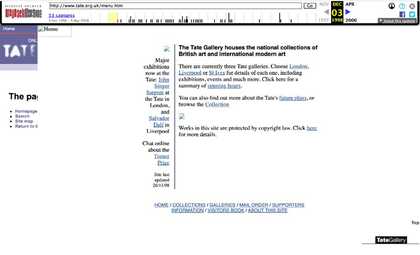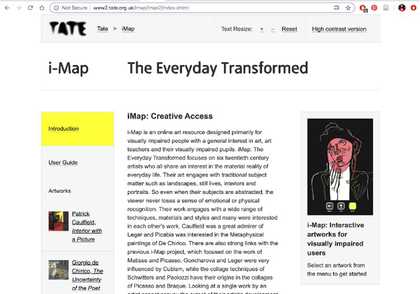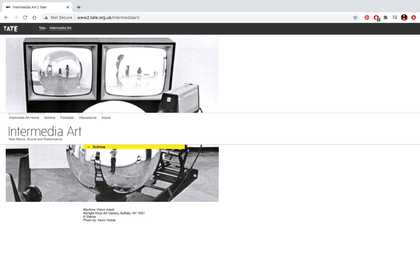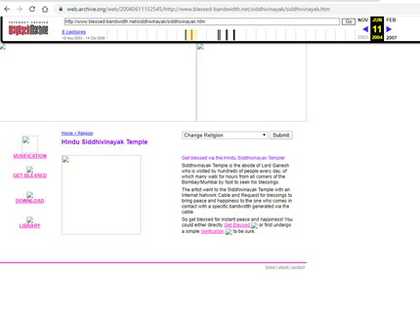
Fig.1
Screenshot of a WayBack Machine capture of Tate’s first website in December 1998
Source: WayBack Machine
Digital image © Tate
Tate Online
The evolution of the Intermedia Art microsite and the net art commissions it housed can be best understood when considering how their development ran in parallel with the history of Tate’s whole online presence. Tate launched its first website in 1998 and this screenshot from a WayBack Machine capture in December 1998 (fig.1) shows a simple ‘first generation’ website.1 It listed the current exhibitions and opening times of each of the three galleries, it included an option to ‘chat online’ about the Turner Prize, and even hosted a visitors’ book. The website fulfilled Tate’s need to hold a space online and while it was impossible to predict the impact the internet would eventually have, there was a recognition of this as a space for collaborative and networked practice. A Digital Programmes team was formed to navigate this digital potential.2
Tate occupying and developing an online space was happening concurrently with the planning for the opening of Tate Modern, the fourth Tate gallery.3 There was an institution-wide consensus that although this was another gallery in London, it had to be a truly national museum and Tate had to find a way to make its collections and practices available outside of a physical museum space.4 In our interview with Honor Hager, Webcasting Curator at Tate during this period, she described how this consensus was keenly felt and added that the website and the net art commissions were also part of conversations ‘around how to bring new voices into the museum … specifically voices of the artists who were engaging with new technologies’.5 As part of the Tate Modern pre-opening programme, Tate commissioned its earliest interactions with net art, a standalone piece entitled /broadcast/ (29 pilgrims, 29 tales) 1999 by Nina Pope and Karen Guthrie.6 Inspired by Geoffrey Chaucer’s Canterbury Tales (1392), the work sent twenty-nine ‘modern day pilgrims’ from Borough Market on journeys of their choosing, returning to the market that evening. The pilgrims would document their journeys, several of which were broadcast live via a studio installation in the market throughout the day. The event could also be streamed live on a website for the artwork which now exists as an archive of the artwork.7
In 2000, to coincide with the opening of Tate Modern, the website was relaunched as Tate Online. With a substantial sponsorship package from BT, this second-generation iteration of the website offered an ‘expanded’ programme that put the collection front and centre, with webcasts, online learning programmes and dedicated microsites for departmental outputs and specific exhibitions.8 It was promoted as Tate’s fifth gallery. Explore Tate Britain and, later, Explore Tate Modern offered interactive virtual tours of the gallery’s collection displays and demonstrated how the website, as the fifth gallery, could be used as a vehicle to make Tate’s practices and collection accessible to global audiences.9 In the same year, the net art programme launched the first two commissions – Graham Harwood’s Uncomfortable Proximity 2000 and Simon Patterson’s Le Match des Couleurs 2000.10 As Tate Online cemented its place as the most popular art website in the UK, Susan Collins proposed Tate’s sixth gallery with her 2002 net art commission, Tate in Space.11

Fig.2
A screenshot of the i-Map: The Everyday Transformed microsite as it appears at the time of writing, December 2020
Digital image © Tate
Not only was Tate Online the most popular art website in the UK, but its use of dedicated microsites for specific exhibitions and learning programmes began to win awards. A significant example was i-Map: The Everyday Transformed (fig.2). This microsite was designed to aid visually impaired people explore the work of Matisse and Picasso.12 The site was awarded a BAFTA Interactive Entertainment Award in 2002.13 It was later extended to include artworks by Patrick Caulfield, Francis Picabia and Natalya Goncharova, and went on to win the 2006 Excellence Award by the Jodi Mattes Trust, a charity that promotes accessible digital culture.14
Intermedia art
In 2006 it was announced that BT would extend their sponsorship of Tate Online for a further three years and continue the ambition for the website to act as a fifth gallery.15 At the same time, the Head of Digital Programmes, Jemima Rellie, stepped away from the net art programme and Kelli Alred moved from the webcasting team and assumed the position of Curator: Intermedia.16 Her first task was to review the commissioning programme and its presence on the website. Previously, the net art commissions had been listed on the Tate homepage, which linked to the different artworks (along with relevant biographies and contextualising texts) as they were launched. Alred took the opportunity to bring the commissions under their own microsite. She reflected on this decision in our interview with her as part of this project:
There felt like there was a big disjuncture between the Net Art commissions and how they were positioned in the museum or how they were understood within the museum itself, as well as by the museum audiences. So, I wanted to link it back to the broader kind of art historical context.17
Beyond using the term ‘Intermedia’ to situate net art within a historical context, Alred also established the direction of the programme going forward, collaborating with Stuart Comer, Tate’s first Curator of Film, and Catherine Wood, then Curator of Contemporary Art and Performance. The website also became an archive for documenting other related programming, such as events and broadcasts that had existed within the arena of Intermedia and had happened elsewhere at Tate during the early 2000s.18 Alred spoke about her vision for the microsite:
Rather than seeing the Intermedia website as a website for a programme, [I saw it as a] website that could highlight the breadth of activities that could be understood at Tate as being involved in Intermedia. So, [it was], kind of, a richer, looser kind of array [of things] that would speak to different audiences in different ways.19
The net art team’s position – both outside of curatorial but within the evolving digital programming department – meant that the Intermedia website became a useful tool in demonstrating how, when Net Art itself sat outside of the traditional expectations of the museum, it was in fact rooted in both art history and traditional gallery programming. This can be seen in the list of events and broadcasts on the Intermedia Art microsite.
Using the Intermedia Art microsite

Fig.3
Screenshot of the Intermedia Art microsite homepage as it appears at the time of writing, December 2020
Digital image © Tate
Artwork © Steina
In December 2020, at the time of writing, the Intermedia Art microsite is working well considering it has not been actively maintained for eight years. Visually, its datedness is evident (fig.3). Designed for older browsers, it does not fit the window size of current ones and instead is squeezed entirely in the left-hand side of the screen, leaving an expanse of empty space on the right. The homepage is divided into four sections: ‘Archive’, ‘Podcasts’, ‘Discussions’ and ‘About’. ‘Archive’ is where all the programming for the project can be found; this includes the fourteen net art commissions, twelve events, seven broadcasts, eight interviews and eighteen contextualising texts. The microsite is a complicated network of links that connects each artwork with corresponding texts, artist biographies, similar works and events, as well as any external links such as ‘further references’ pages or links present within the artworks themselves.

Fig.4
Screenshot of a Wayback Machine capture of Shilpa Gupta’s Blessed Bandwidth in 2004
Source: WayBack Machine
Digital image © Tate
As part of this case study, the Intermedia Art microsite has been archived and will enter Tate’s Public Records collection as the first website to be archived in-house.20 To do this, a systematic check of each component of the site was undertaken in which each link was clicked. All but four of the net art works are working in some form or another depending on the browser and user permissions for Flash, the software for viewing multimedia content which will no longer be updated as of December 2020. Artworks such as Achim Wollschied’s Nonrepetitive 2011, Marek Walczak and Martin Wattenberg’s Noplace 2008 and Shilpa Gupta’s Blessed Bandwidth 2003 are no longer hosted by the artists and are now unavailable.21 As Blessed Bandwidth was one of the earlier net art commissions, there are several captures of the work on the Internet Archive’s Wayback Machine; almost all the images, however, are broken, limiting its interactivity.22 As the case study unfolded, Natalie Bookchin and Jacqueline Stevens took down agoraXchange 2004 and the website now includes a link to a version archived by the Wayback Machine in February 2020.23 Due to Graham Harwood’s Uncomfortable Proximity 2000 being an interventional artwork originally triggered by every third visitor to the Tate website, we have not been able to experience this work in full.24 The work exists now as a digital scrapbook of images and texts about each ‘Mongrel’ site the visitor would have seen. I have found Golan Levin’s The Dumpster 2006 works sporadically in Internet Explorer browsers with Java permissions enabled.25 Tate in Space no longer links via the Intermedia Art microsite – the link produces a 404 error message – but it can be accessed via search engines.
The net art programme was one of Tate’s earliest attempts to reach wider audiences with podcasts.26 The Infrequency podcasts were a series of live performance recordings and artist commissions recorded in conjunction with Tate’s Intermedia Art programme and described as ‘infrequent and intriguing, building on and developing a legacy of avant-garde and contemporary sound and electronic music.’27 They included works from the commissioned artists such as Achim Wollschied, and recordings of linked events by Christian Marclay and Tony Conrad. The podcasts are no longer available via the Intermedia Art microsite, but they can still be found and downloaded from other podcast services.
The ‘Discussions’ section of the Intermedia Art microsite features two interactive forums. They were produced as part of a course entitled Sound and the Twentieth Century Avant-Garde, which was itself part of the programming for the exhibition Bruce Nauman: Raw Materials.28 The two forums, moderated by Lina Dzuverovic, a researcher and co-director of Electra Productions, asked people over a seven-week period in 2005 to respond the following question:
As we shift from electromagnetic tape to digital codec as a low-cost method of underground and independent distribution and exchange what implications evolve regarding the form, practice and politics of sound?29
This section of the Intermedia Art microsite speaks to Alred’s earlier comments – and demonstrates the commitment Tate was making to Intermedia programming in the early 2000s – by bringing these collaborative endeavours under one microsite.
As part of the case study, the website – in its current state, the authentic record of how we came to find it when starting this research – has been archived using Rhizome’s Conifer tool.30 Conifer is a free, open-source web archiving software that focuses on capturing ‘dynamic web content’ such as embedded video, flash, audio and complex javascript. It thus allows us to capture as much interactivity as possible and preserve the website in the condition that we found it.31 The archived website will enter Tate’s Public Records collection.
New strategies
When the BT sponsorship came to an end in 2010, John Stack, then Tate’s Head of Digital, published Tate’s online strategy for 2010–12, which set new intentions for the website.32 The strategy began by highlighting how radically the internet – and users’ expectations of it – had changed in such a short space of time. It acknowledged changing mobile technologies, and users’ desire to move from content to interaction. It boldly states that ‘much of Tate Online is a relatively flat, even monolithic and impervious, website’.33 The website as Stack saw it failed to match up to the early excitement around Tate Online, and in particular the intention to make available online as much of Tate’s activity, programme and collection as possible.
The 2010–12 strategy intended to rebrand Tate Online as ‘a dimension of practically everything Tate does, from research and conservation to fundraising and public programmes’.34 The introduction to the new strategy also saw the Intermedia Art project come to an end. As previously mentioned, Alred’s working relationship with Tate curators Stuart Comer and Catherine Wood demonstrates that ‘new media’ was being addressed via curatorial practices within the gallery.35 The project could potentially have continued with a renewed focus on the ‘sociality’ of the internet that was very present in the strategy – the use of the internet as an extension of artistic networks in early net art practices is a topic covered extensively in histories of net art.36 In our interviews with the commissioned artists, however, there was a sense that many of their relationships with, and interest in, net art changed as the internet became more prevalent in society.37 The new strategy also saw the whole website redesigned in 2012; however, that is not to say that these things have not had a lasting legacy. For example, Tate Learning developed a series of detailed ‘Work in Focus’ resources which, as the title suggests, looked at several key works in the collection in greater detail. These pages were redesigned to fit the new template, and now exist as the ‘Look Closer’ features on the ‘Art & Artists‘ pages.38
Alongside the Infrequency podcasts, other technologies on the Intermedia Art microsite have continued to expire as developers have stopped supporting them and some artists have stopped maintaining servers and host websites. The last digital strategy in 2013–15 makes no reference to microsites or net art but is subtitled ‘Digital as a Dimension of Everything’.39 The strategy states that as the digital has moved beyond the concern of one specific department, that the need for such distinct outputs would be replaced by a ‘holistic digital proposition’ that speaks to its subtitle.
Conclusion
The excitement around the internet as a new tool can be felt in our interviews with both the artists and former Tate staff. As the fifth gallery, Tate Online offered greater connectivity and allowed wider access not only to the collection but also the work of departments such as learning and interpretation with the i-Map project and ‘Works in Focus’ features both emerging from this period of BT’s sponsorship. Tate’s series of online strategies and the end of the net art commissions demonstrate that the internet evolved and became a tool to be integrated within institutional practices – its role as a vehicle of experimental practice had waned.
The participatory and accessibility legacy of Tate Online has been keenly felt at the time of writing as the COVID-19 pandemic has forced the closure of museums and galleries, many of which have transferred part of their programmes to an online space. Towards the beginning of the pandemic in the UK, in April 2020, Tate quickly produced virtual tours for the then newly opened Andy Warhol and Aubrey Beardsley exhibitions, which have been viewed over 210,000 and 98,000 times respectively.40 Tate has also streamed several workshops, events, performances, and talks during both national lockdowns; and Uniqlo’s Late at Tate events were rebranded as Uniqlo Tate Late Nights In.41 We can speculate that in 2000 the newness and novelty of the internet as a tool – paired with the desire to make the website the fifth gallery – meant that departments were ambitious, eager and generous with their online offerings. This sentiment was echoed in the 2010 strategy, which claimed that this enthusiasm had made the website unwieldly, ’monolithic and impervious’.42
As the internet very rapidly became an everyday tool rather than a vehicle for experimentation, those whose access to museums and galleries had been widened by these new tools of accessibility were seemingly left behind when online offerings were streamlined and enthusiasm was directed elsewhere. These are conversations that have been echoed by disability activists in the current pandemic who have seen public institutions, workplaces, and universities readily resource and adapt to the online environments in ways activists had been requesting for years.43 The pandemic is still ongoing and we do not yet know what the future holds for many cultural institutions, but it does offer an opportunity and another perspective from which to reflect on the space that Tate occupies online, and how these moments of adaptable practice have the potential to build a more inclusive and considered museum practice both on and offline.
This case study has also raised questions about the record of Tate’s digital output and capability of internet archiving tools to capture the dynamic content that art galleries and artists wish to produce, and audiences have come to expect. As the Intermedia Art microsite enters Tate’s collection of Public Records as the first website archived in-house, the Tate Digital team webpage now includes a link to archived versions of the website.44
